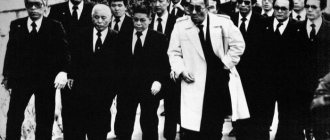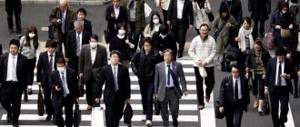The yen (円 in Japanese) is the currency of Japan. It is the third most popular currency on the foreign exchange market, after the American dollar and the euro. The yen plays the role of a reserve currency after the US dollar, euro and pound sterling. The ISO code for 4217 yen is JPY and 392. The Western (romanized) symbol for yen is ¥, and in Japan it is written using the kanji system - 円. Although not inherent to the currency, large amounts of yen are counted multiplied by 10,000 (man, 万), similarly American money is often rounded to the nearest hundreds or thousands.
Story
Introduction
The yen was introduced by the Meiji government in 1872 as a system reminiscent of the European one. The yen replaced the complex monetary system of the Edo period, which was based on the mon currency. The New Currency Act of 1871 led to the introduction of a decimal accounting system: yen (1, 圓), sen (sen 1⁄100, 錢) and rin (rin 1⁄1000, 厘). The coins were round and cast like in the West. Officially, the yen was worth 0.78 troy ounces (24.26 grams) of pure silver, or 1.5 grams. pure gold. The same amount of silver today costs 1,181 yen, and the same amount of gold costs 3,572 yen. The act also moved Japan to the gold standard. (Sen and rin were withdrawn from circulation at the end of 1953).
Fixed value of the yen compared to the US dollar
The yen lost value during World War II and the post-war period. After a period of instability in 1949, in order to stabilize the Japanese economy, the value of the yen was set at 360 yen per US dollar, according to the US plan that was part of the Bretton Woods monetary system. This exchange rate was maintained until 1971, when the US ended the gold standard, which had been the mainstay of the Bretton Woods system, and imposed a 10% increase in import costs, ushering in the changes that led to the floating exchange rate system in 1973.
Undervalued yen
By 1971, the value of the yen had declined significantly. The value of Japanese exports in the international market was very low, and imports from other countries were too expensive for Japan. This decline in value was reflected in the current account balance, which rose from the deficits of the early 1960s to US$5.8 billion by 1971. The fact that the yen and several other major currencies had fallen in value motivated US action in 1971.
Floating exchange rate of the yen and major currencies
Following US measures to depreciate the dollar in the summer of 1971, the Japanese government agreed to a new fixed exchange rate that was part of the Smithsonian Agreement signed at the end of the year. Under this agreement, the exchange rate was 308 yen to 1 US dollar. However, sticking to the new exchange rate under the Smithsonian Agreement was difficult due to supply and demand pressures in the foreign exchange market. In early 1973, taxes were eliminated and the world's largest nations allowed their currencies to float.
Japanese government intervention in the foreign exchange market
In the 1970s, the Japanese government and businessmen were very concerned that the rising value of the yen could harm export growth by making Japanese products less competitive, which would negatively affect industrial development. The government continued to intervene in the foreign exchange market (by buying or selling dollars) even after the agreement to float the yen in 1973.
Despite the intervention, market pressure continued to increase the value of the yen, temporarily stalling at 271 yen to US$1 in 1973 before the impact of the fuel crisis became felt. The increase in the cost of oil imports caused the value of the yen to rise to 290 - 300 yen in the period 1974 - 1976. The re-emergence of a trade surplus again reduced the currency's value to 211 yen in 1978. This currency appreciation was reversed again after the second fuel crisis in 1979, when the value of the yen declined to 227 yen by 1980.
Yen in the early 1980s
During the first half of the 1980s, the value of the yen did not rise, despite the fact that the current account surplus grew rapidly. From 221 yen in 1981, the average value of the yen changed to 239 yen in 1985. The rise in the current account surplus stimulated demand for the yen in foreign currency markets, but it was diverted by other factors. The large differential in interest rates, with US rates much higher than Japanese rates, and the continued deregulation of international capital movements led to large capital outflows from Japan. This capital outflow increased the supply of yen to foreign currency markets, as Japanese investors exchanged yen for other currencies (mostly dollars) to invest abroad. For this reason, the yen remained weak compared to the dollar, which triggered a sharp increase in Japan's trade surplus in the 1980s.
Impact of the Plaza Agreement
In 1985, significant changes began. Financial officials of developed nations signed an agreement (the Plaza Agreement) confirming that the dollar was overvalued (and therefore the yen was undervalued). This agreement, along with inconsistent supply and demand pressures in the markets, caused the value of the yen to soar. From a low of 239 yen to the US dollar in 1985, the yen rose to a peak of 128 yen in 1988, nearly doubling its value against the dollar. After some decline in value in 1989 and 1990, the currency rose again to 123 yen per US dollar in December 1992. In April 1995, the yen peaked at nearly 80 yen to the dollar, temporarily bringing the Japanese economy closer to the size of the US.
Years after the bubble
The value of the yen declined with biased stock market pricing in Japan, reaching 134 yen per US dollar in February 2002. The Bank of Japan, with its zero rate policy, discouraged yen investment by transport trading investors borrowing yen and investing in higher value currencies (thus further devaluing the yen). Foreign currency borrowing totaled 1 quintillion dollars in February 2007. Economists have suggested that the yen is undervalued against the dollar by 15%, and by 40% against the euro.
Is the Japanese currency comparable to the ruble?
There is a downward trend in the cross rate of the Yen against the ruble. However, it is significant only for traders trading on intraday turnover.
The Japanese currency against the ruble is stable and has a narrow range of amplitude fluctuations, which makes it possible to predict the behavior of both monetary units in the long term.
What is the secret of the Japanese miracle? The answer lies on the surface:
- Low % unemployment.
- High demand for deposits among residents.
- The vector of state policy is to increase the well-being of citizens.
But keep in mind, the Japanese mentality is a 100% guarantee of the success of the country’s economic growth. Government support for domestic consumers leads to mutual support among Japanese residents for the elected government, which avoids exhaustive militarization of the economy.
Coins
Coins were introduced in 1870. There were silver 5, 10, 20 and 50 sen, as well as 1 yen, and gold 2, 5, 10 and 20 yen. The gold 1 yen was introduced in 1871, followed in 1873 by the copper 1 rin, ½, 1 and 2 sen.
The copper-nickel 5 sen coin was introduced in 1889. In 1897, the silver 1 yen was withdrawn from circulation, and the sizes of the gold 5, 10 and 20 yen coins were reduced by 50%. In 1920, cupro-nickel 10 sen coins were introduced.
Silver coin production ceased in 1938, after which various base metals were used to produce 1, 5 and 10 sen coins during World War II. Clay 5 and 10 sen coins were issued in 1945 but did not enter circulation.
After the war, brass 50 sen, 1 and 5 yen were introduced between 1946 and 1948. In 1949, the current style of the 5 yen with hole was introduced, followed in 1951 by the bronze 10 yen (still in circulation).
Coins of denominations less than 1 yen became invalid on December 31, 1953, following the Small Currency and Fractional Payment Rounding Acts (Shōgaku tsūka no seir). i oyobi shiharaikin no hasūkeisan ni kan suru hōritsu) .
In 1955, the current version of the aluminum 1 yen and nickel 50 yen coin without hole was issued. These were replaced in 1967 by the current cupro-nickel coins, as well as the 50 yen hole coin. In 1982, the first 500 yen coins were introduced.
The date appears on the reverse side of the coin, and the name 日本国, Nihonkoku (Japan) and the kanji denomination are written on the obverse side, except for the 5 yen, where Nihonkoku is written on the reverse side.
The 500 yen coins are among the most valuable coins used in the world (approximately US$4.86, €3.12, and £2.46). The most valuable of the commonly used American coins (25¢) is worth approximately 26 yen; Europe's most valuable coin (€2) is worth 321 yen, and the UK's (£2) is worth 406 yen (April 2008). The Swiss 5-franc coin is currently (April 2008) worth about 505 yen, which is slightly more than the Japanese 500 yen coin. With such a high value, it is not surprising that the 500 yen coin has become a favorite target for counterfeiters. It was counterfeited in such quantities that in 2000 a new series of coins with security properties was released. Despite these changes, counterfeits continue.
For various significant occasions, commemorative coins of various denominations up to 100,000 yen are made of silver and gold. Although they can be used, they are more of a collector's item.
Instead of indicating the year of issue, as on all other coins, Japan's coins indicate the year of reign of the current emperor. For example, if a coin was issued in 2006, it will bear the date Heisei 18 (the 18th year of Emperor Akihito's reign).
Dynamics of the Japanese yen exchange rate
The good dynamics of the Japanese yen exchange rate is due to three reasons. The first is economic stability and large volumes of exports in the state. The second is the status of a world reserve currency (although the volume of international savings has decreased slightly compared to 1999-2000). Finally, the third is a free course. The value of the local currency is determined solely by the current economic situation and is not fixed by the bank or government.
In recent years, the dynamics have not been the best, but the yen maintains its status and remains in demand among players and investors.
Banknotes
Issue of yen banknotes began in 1872, two years after the currency was introduced. Throughout history, banknotes have been issued in a range from 10 sen to 10,000 yen.
Before and during World War II, various authorities issued yen banknotes, such as the Ministry of Finance and the National Bank of Japan. Japan's allies also produced some banknotes in the post-war period. Since then, the Bank of Japan has remained the sole banknote issuing authority. Since World War II, the bank has issued five series of banknotes. The current series, Series E, consists of banknotes in denominations of 1,000, 2,000, 5,000, and 10,000 yen.
| 1000 yen | |
| 2000 yen | |
| 5000 yen | |
| 10000 yen | |
Japanese currency against the dollar: reality and fiction
The dynamics of the specified JPY/USD pair reflects purely economic processes.
The peak of the exchange rate with a linear sideways trend of 125.61 occurred in the summer. To date, there has been a decrease of 1.51 points, which is due to a number of factors:
- Differences in the monetary policies of both countries.
- Lack of significant influence of the Euro on the Yen.
You can make your own forecast. When predicting the trajectory of the JPY, keep in mind that the Japanese currency will decline against the dollar due to factors:
- Programs for increasing the Asian money supply.
- Reductions in US export operations due to the tripling of the dollar.
Determining Value
The relative value of the yen is determined in the foreign currency market by economic factors of supply and demand. The supply of yen to the market is governed by the desire of currency holders to exchange it for another in order to purchase goods, services or shares. Demand for the yen depends on the desire of foreign visitors to buy goods and services in Japan and on their interest in investing in Japan (buying financial stocks with yen).
Beginning in December 1931, Japan gradually moved away from a gold standard system to a managed currency system.
Tips for tourists
Payment terminals are not available everywhere. In Japan, cash is used more often than cards. The main advice for travelers is to always have paper money. You can withdraw funds from your account through 24-hour stores (almost all have an ATM).
Where is the best place to exchange money?
Exchange operations are available:
- in the bank;
- at the post office;
- at the exchange office.
The course is practically the same. The most convenient option is an exchange office in the airport terminal.
Exchange is possible in your home country - at a bank or a special point.
Currency can be exchanged at home
Tipping in Japan
In the Land of the Rising Sun, it is not customary to tip, since wages are entirely the responsibility of the employer. If the client is satisfied with the service, he can give the envelope filled with money. When transmitting, the object is held with both hands and bowed to the recipient, expressing respect.
Some cafes have jars for change. You can leave unnecessary small change in them.
There is no tipping in Japan
Yen as a reserve currency
For decades, the Japanese currency has been considered a reserve currency and is extremely popular among investors and players. It is considered second in importance. However, in recent years, the yen as a reserve currency has not pleased investors: the volume of funds around the world has decreased by more than 5% since the beginning of the new millennium.
The reasons for this are problems in the country’s economy, which led to excessive strengthening of the currency and deflation. The authorities are taking all measures to reduce the exchange rate and make it less stable, but this does not help much. Despite the problems, it still competes with the British pound sterling and the Swiss franc.
Gold standard of the Japanese yen
Since its inception, the yen has been on the gold standard. One unit was equal to 1.5 gold. In a short time it has undergone significant changes. The gold standard of the Japanese yen was introduced and canceled more than once, focusing on the current situation and economic indicators. By the end of the 30s, the standard was completely abolished. However, some analogue of this standard remains.
The yen gained international recognition in 1953. At this time, the cost of one yen was 2.5 milligrams, but subsequently it increased significantly. It is now one of the most reliable gold-backed currencies.
Monetary circulation of the 8th – 9th centuries
The ability of coins to connect producers and consumers was not appreciated by the Japanese for a long time. Most residents did not need goods from outside at all, since everything they needed was available at home. And in the absence of better options, the state actively traded in official positions in order to somehow support the movement of its issued funds. There were also peasants who performed labor duties in the capital. Deprived of their personal household, they received their salaries in cash.
In the mid-8th century, Japanese authorities began minting copper coins of larger denominations. Their weight was 5 grams and their diameter was 27 millimeters. One new coin was equal to ten old ones, which were intended to be withdrawn from circulation and melted down. It should be noted that the quality of the newly minted money was significantly inferior.
The next minting of Japanese coins took place in 958. The purchasing power of old money, due to constant inflation, was greatly reduced. And in the 10th century, the minting of sen, as Japanese money of that time was called, ceased altogether. The ensuing period was characterized by the collapse of the centralized state.
Deflation of the Japanese yen
A strong currency has its drawbacks, as can be seen from the example of Japan. Deflation of the Japanese yen is associated with overproduction and forces the government to take various measures to control exchange rates. At some points, there were attempts to reduce the value of the local currency artificially (quantitative easing). It may be used repeatedly.
Excessive strengthening (growth) of the currency leads to a decrease in export volumes, increased labor costs, as well as other negative phenomena. For this reason, Japan is carrying out economic reforms and trying to accelerate inflation.
Origin of the name yen
The origin of the name yen is curious. It is connected with the history of trade in Asia. During the Qing Dynasty, China used yuan - silver bars. In the 18th century, silver coins were brought to China from Mexico and Spain, which became known as Western yuan. Then the British started producing silver coins, which they called Hong Kong yuan - after the place of issue. They eventually ended up in Japan, where they received the name in Japanese - “en”. Subsequently, the “en” gradually transformed into the yen. Already in 1830, they began to issue their own coins here. The official name “yen” appeared a little later.











